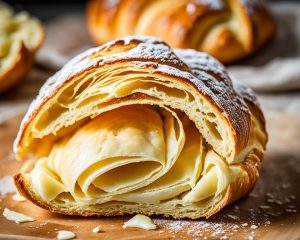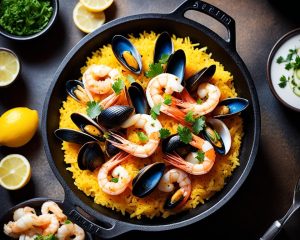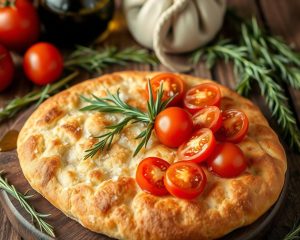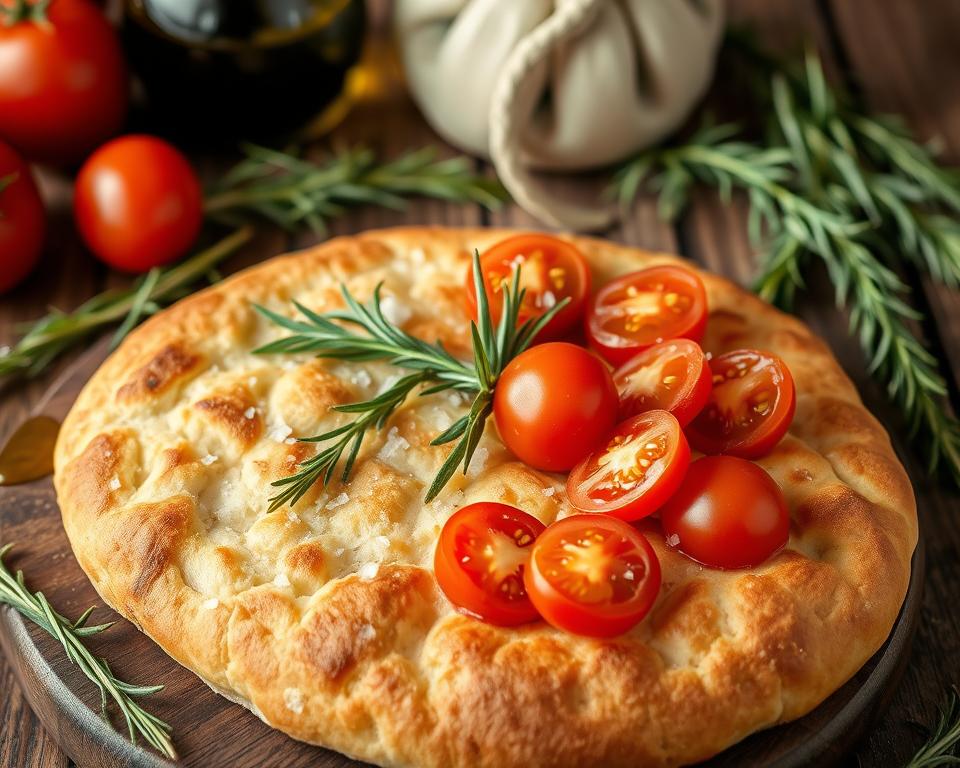
Get ready to explore the world of Italian cuisine with this guide to making focaccia. This beloved flatbread is known for its golden crust, dimples, and flavors of olive oil, rosemary, and sea salt. It’s a true showcase of Italy’s culinary skill.
In this article, you’ll learn about focaccia’s origins and varieties. You’ll also discover how to make this versatile Italian bread. From making the dough to trying different toppings, you’ll be able to make focaccia that takes you to Italy with every bite.
Read interesting things at : web-quanto
Key Takeaways
- Explore the rich history and regional variations of authentic Italian focaccia bread.
- Discover the secrets to creating a perfectly dimpled, flavor-infused focaccia crust.
- Learn how to knead and proof the focaccia dough for optimal texture and rise.
- Experiment with a variety of classic and creative focaccia toppings to suit your taste preferences.
- Understand the versatility of focaccia in Italian cuisine, from serving as a side dish to a main course.
What is Focaccia?
Focaccia is a Italian bread from Liguria, in northwest Italy. It has a long history, dating back to ancient Rome. Today, it’s a favorite in Italian homes. The dough is simple: flour, yeast, olive oil, and water. It’s often topped with rosemary and sea salt.
Origins of Focaccia
The story of focaccia starts with the ancient Romans. They made a flatbread called panis focacius. This bread was cooked on the hearth, or focus. As the Roman empire grew, so did the flatbread, reaching Liguria.
Varieties of Focaccia
- Classic Focaccia: Topped with olive oil, rosemary, and sea salt
- Focaccia Genovese: The traditional focaccia from Genoa, often topped with onions, olives, and anchovies
- Focaccia Barese: A variation from the city of Bari, featuring tomatoes, olives, and oregano
- Focaccia Dolce: A sweet version of focaccia, sometimes topped with grapes, figs, or other fruits
While the classic focaccia is well-known, Liguria has many regional versions. Each has its own flavors and toppings.
Focaccia: A Taste of Italian Tradition
Focaccia is more than just an Italian bread. It’s a celebration of Italy’s rich culinary heritage and the Mediterranean’s flavors. The dimpled texture and fragrant aroma of a freshly baked focaccia remind us of Italian homes. Here, this versatile flatbread is often served as a side dish, appetizer, or even a main course.
The secret to focaccia’s unique taste is high-quality olive oil and aromatic herbs like rosemary. These simple yet flavorful ingredients come together to create a bread that’s both comforting and sophisticated. It captures the essence of Italian cuisine.
Focaccia is a testament to Italian baking traditions passed down through generations. Each region of Italy has its own unique focaccia, reflecting local ingredients and culinary preferences. From Liguria’s savory, herb-infused focaccia to Puglia’s sweet, fruit-topped versions, the variations are as diverse as the Italian landscape itself.
“Focaccia is not just a bread, it’s a way of life. It’s about embracing the simple pleasures, gathering with loved ones, and savoring the flavors that bring us closer to our roots.”
Focaccia is a true taste of Italian tradition, enjoyed as a side dish or a standalone snack. Its versatility and timeless appeal have made it a beloved staple in kitchens worldwide. It’s a testament to the enduring power of Italy’s culinary legacy.
The Perfect Focaccia Dough
Making the perfect focaccia dough is key to a delicious, yeasted flatbread. This Italian bread needs the right mix of ingredients and techniques for a light texture. Let’s look at how to make the focaccia dough just right.
Ingredients for Focaccia Dough
The basic focaccia dough needs just a few things:
- All-purpose flour
- Warm water
- Yeast
- Olive oil
- Salt
The right mix of these ingredients is important. The flour to water ratio is crucial for the dough’s texture.
Kneading and Proofing Focaccia Dough
After mixing the ingredients, kneading and proofing start. Kneading builds the dough’s gluten, making it soft and fluffy. Then, the dough proofs, letting yeast create airy pockets in the focaccia dough.
Proofing time varies, but aim for at least an hour. This lets the yeasted flatbread reach its best.
“The secret to the perfect focaccia lies in the dough – it must be handled with care and allowed to proof to perfection.”
Focaccia Toppings and Flavors
Focaccia is a versatile Italian flatbread perfect for many toppings and flavors. It ranges from the classic olive oil, rosemary, and sea salt to more creative options. Let’s look at some popular focaccia toppings to spark your next baking project.
Classic Focaccia Toppings
Some toppings are timeless favorites for focaccia. The mix of olive oil, rosemary, and sea salt is a classic. It brings together the peppery rosemary, the richness of olive oil, and the crunch of sea salt. This combination captures the heart of Italian cuisine.
Other classic toppings include:
- Sliced olives, both green and black, for a briny punch
- Sautéed onions, caramelized to perfection for a sweet and savory contrast
- Sun-dried tomatoes, which add a concentrated burst of flavor
- Fresh herbs, such as thyme, oregano, or basil, for a fragrant touch
These classic toppings highlight the focaccia dough’s natural flavors. They add depth and complexity to the dish.
“Focaccia is a canvas for endless flavor combinations, limited only by one’s imagination.”
Baking Delicious Focaccia Bread
Making perfect focaccia is the last step in this Italian flatbread journey. To get a golden-brown crust, soft inside, and dimpled texture, follow some key steps.
The oven temperature is key. Focaccia needs high heat, about 400°F (200°C), for a crispy outside and fluffy inside. Baking on a preheated stone or sheet helps get that perfect texture.
- Preheat the oven to 400°F (200°C) and warm a baking stone or sheet.
- Put the proofed dough on the hot surface without deflating it.
- Bake for 20-25 minutes until it’s golden and cooked inside.
- Don’t open the oven too often to avoid the focaccia falling.
After baking, let the focaccia cool a bit before serving. Then, drizzle it with olive oil and sprinkle with herbs like rosemary or thyme for a true Italian taste.
“Baking focaccia is an art form that takes practice, but the reward is a delicious, dimpled bread that transports you straight to the coastal regions of Italy.”
Serving and Enjoying Focaccia
Focaccia, the delightful Italian flatbread, can be enjoyed in many ways. It’s perfect as a side dish or as the main course. This versatile bread adds a Mediterranean flair to any meal.
Focaccia as a Side Dish
Focaccia is great with soups, stews, and salads. Its spongy texture and savory flavors balance rich dishes or contrast fresh greens. Slice it into wedges or squares and arrange it artfully on the plate.
Focaccia as a Main Course
The classic Italian pizza bianca, or white pizza, shows how focaccia can be a main dish. Top it with olive oil, fresh herbs, and various toppings like roasted vegetables or creamy cheeses. Slice it into generous portions and serve it as the meal’s centerpiece.
No matter how you serve it, focaccia will delight your senses and bring Italy to your table. Try different toppings and presentations to find your favorite way to enjoy this beloved serving focaccia and pizza bianca treat.
Focaccia: A Versatile Italian Bread
Focaccia is more than just olive oil and rosemary. It can be made with many toppings and flavors. You can add savory herbs, olives, or even sweet toppings like grapes or caramelized onions. This Italian bread can be turned into a delicious bread loaf for many occasions.
Focaccia stands out because it can be made in so many ways. Its light texture and mild taste are perfect for different toppings. Whether you like it savory or sweet, focaccia can match any meal or snack.
Savory Focaccia Varieties
- Rosemary and Garlic
- Sundried Tomato and Basil
- Caramelized Onion and Feta
- Olive and Herb
Sweet Focaccia Varieties
- Grape and Honey
- Cinnamon and Apple
- Cherry and Almond
- Lemon and Blueberry
Focaccia is a versatile and tasty Italian bread. It can be enjoyed in many ways, from a side dish to a main course or even a dessert. This bread loaf is a must-try in Italian cuisine, sure to please your taste buds.
“Focaccia is the perfect canvas for culinary creativity. Its light, airy texture and subtle flavor profile make it the ideal base for endless flavor combinations.”
Focaccia: Olive Oil and Rosemary Delight
At the heart of focaccia is a perfect mix of olive oil and rosemary. This Italian flatbread shows the beauty of simple, quality ingredients.
The secret to great focaccia is top-notch olive oil. It adds a rich flavor and a golden crust. A drizzle of olive oil before baking makes it look and taste amazing.
Rosemary adds a special touch to focaccia. Its earthy flavor goes well with olive oil. As it bakes, the aroma of rosemary fills the air, making you think of Italy.
| Ingredient | Quantity |
|---|---|
| Olive Oil | 1/4 cup |
| Fresh Rosemary | 2 tablespoons, finely chopped |
The best focaccia is a mix of olive oil and rosemary. It’s a taste of Italy. Enjoy it as a snack or with other dishes.
“The true essence of focaccia lies in the perfect marriage of olive oil and rosemary. It’s a culinary symphony that captures the very soul of Italian cuisine.”
Mastering the Dimpled Focaccia Bread
The dimpled texture of focaccia is not just pretty. It also makes the bread taste and feel special. Learning to make these indentations is key to making your focaccia stand out.
To get the perfect dimples, start during the dough’s proofing and shaping. Press your fingers gently into the dough after it rises. This creates the dimples that will look great when baked. But, don’t overwork the dough. This can make it dense and lose its light, airy feel.
After shaping and dimpling, it’s time to bake. Bake the focaccia at about 400°F (200°C). This temperature helps the dimples set and gives the crust a nice crispiness. Also, drizzle olive oil on the dough before baking. This adds flavor and makes the focaccia even better.
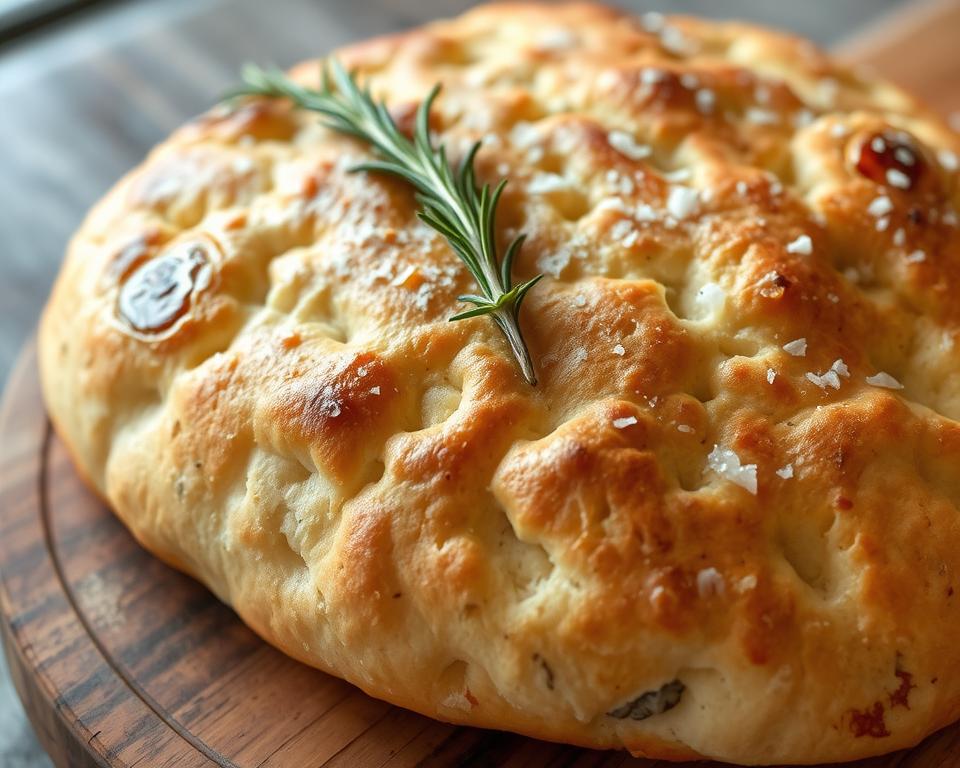
By mastering the dimpled texture, you’ll enjoy homemade focaccia that looks amazing and tastes incredible. It’s a truly satisfying experience.
| Technique | Description |
|---|---|
| Proofing and Shaping | Gently press fingertips into the dough after the initial rise to create the dimpled texture, being careful not to overwork the dough. |
| Baking Method | Bake the focaccia at a high temperature, around 400°F (200°C), to set the indentations and create a crisp, golden-brown crust. Drizzle the dough with olive oil before baking. |
Focaccia: The Yeasted Flatbread of Ligurian Cuisine
Focaccia is a beloved staple in Ligurian cuisine, with a long history in Liguria, Italy. It’s a yeasted flatbread that has become a symbol of local culture and flavors. This bread is rooted in the rich traditions of the Italian peninsula, making it a cherished part of the country’s culinary scene.
The origins of focaccia date back to ancient Roman times. The people of Liguria started experimenting with yeasted doughs and baking techniques. Over time, the recipe changed, incorporating local ingredients and reflecting the region’s culinary influences. Today, focaccia is a testament to Liguria’s culinary heritage, offering a true taste of Italy.
Focaccia comes in many varieties, from classic olive oil and rosemary to adventurous toppings celebrating local produce. It’s loved as a side dish, main course, or snack. This yeasted flatbread brings the Ligurian coast’s flavors to life in every bite.
Focaccia’s popularity in Ligurian cuisine shows the region’s love for quality, local ingredients and traditional baking. As a versatile and flavorful yeasted flatbread, focaccia is a key part of Italian cuisine. It offers a delicious and authentic taste of the Ligurian coast.
Focaccia: A Bread Loaf Like No Other
Focaccia is famous for its flatbread form, but it can also be a stunning loaf. It’s perfect as a main dish or a meal centerpiece. This Italian bread turns into a tall, fluffy loaf when baked. It’s great for slicing and enjoying in many ways.
To make a focaccia loaf, the dough is first proofed. Then, it’s shaped into a tall, rectangular or oval form before baking. The result is a soft inside and a golden-brown crust. It’s perfect for soups, stews, or as a base for toppings.
- Shaping the Dough: After the initial proofing, the focaccia dough is gently stretched and shaped into a tall, rectangular or oval form, ensuring an even thickness throughout.
- Proofing the Loaf: The shaped dough is then allowed to proof a second time, giving it time to rise and develop its signature texture.
- Baking the Loaf: When ready, the focaccia loaf is baked at a high temperature, resulting in a crisp, golden-brown crust and a soft, airy interior.
The focaccia bread loaf is very versatile. It can be a main dish with toppings or a side for soups. Its tall, fluffy shape makes it a beautiful centerpiece for any meal.
| Ingredient | Quantity |
|---|---|
| Bread Flour | 4 cups |
| Warm Water | 1 1/2 cups |
| Olive Oil | 1/4 cup |
| Yeast | 2 teaspoons |
| Salt | 1 teaspoon |
Trying a focaccia bread loaf is a must for bread lovers. It has a great aroma, fluffy texture, and endless topping options. This Italian classic is a standout in baked goods.
“The smell of freshly baked focaccia bread is enough to make anyone’s mouth water. It’s a true delight for the senses.”
Focaccia: The Italian Pizza Bianca
Focaccia, the iconic Italian flatbread, is closely related to the classic pizza bianca, or “white pizza.” Both are loved for their simple yet tasty mix of olive oil, fragrant herbs, and sea salt. We’ll look at the similarities and differences between these two Italian breads. You can also use your homemade focaccia to make your own pizza bianca.
Focaccia and pizza bianca are not just distant cousins; they’re closely related. Both come from the Ligurian region of Italy, famous for its rich food traditions and coastal vibe. The main difference is in how they’re made and presented.
Pizza bianca is a simple white pizza without tomato sauce. It has a thin, crisp crust, brushed with olive oil, and topped with rosemary, garlic, and sea salt. It’s a savory and satisfying flatbread that’s great on its own or with toppings.
Focaccia is a thicker, more pillowy Italian flatbread. It has the same core ingredients but develops a yeasty flavor and chewy texture. The dimples in the focaccia’s surface catch the olive oil and toppings, making each bite special.
To make your own pizza bianca with homemade focaccia, it’s easy. Bake the focaccia, then slice it into wedges or squares. Top it with fresh tomatoes, prosciutto, or roasted vegetables. The focaccia’s crust is perfect for this Italian-inspired flatbread.
Enjoying focaccia as a standalone bread or as a pizza bianca base is a treat. This versatile Italian staple is a delight for the senses. It shows the lasting culinary traditions of Italy.
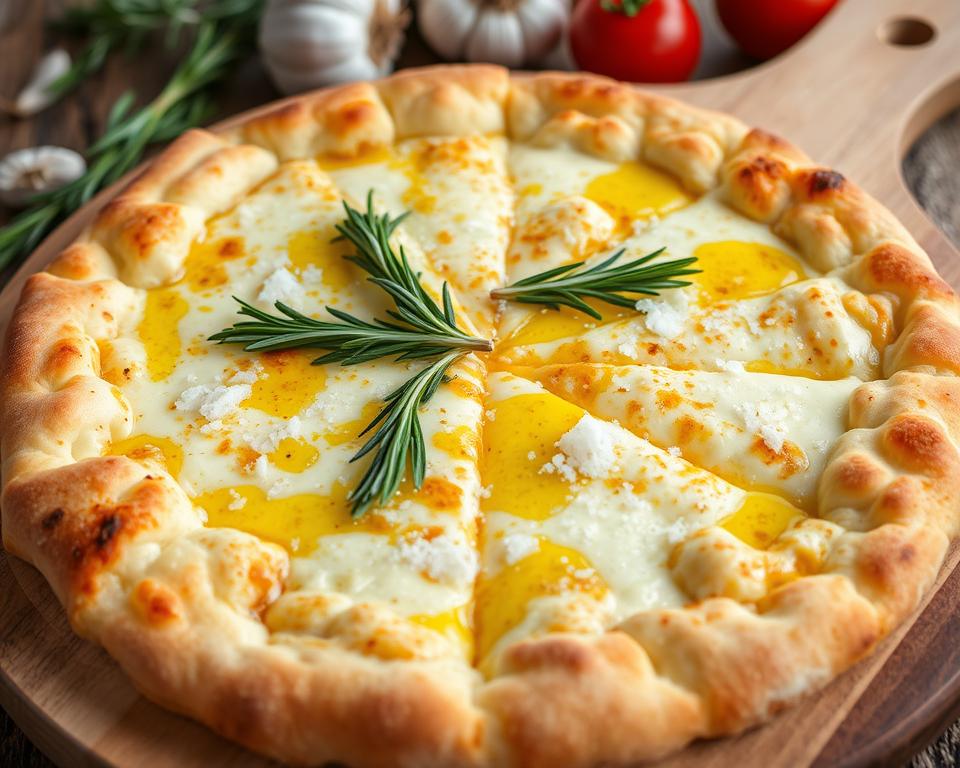
Tips for Perfect Focaccia Every Time
Making perfect focaccia needs focus and a few special techniques. From making the dough to baking it right, these tips will guide you. You’ll learn how to make the delicious, dimpled focaccia you’ve always wanted.
- Use the best ingredients. Choose extra-virgin olive oil, fresh herbs, and quality flour for the best taste.
- Knead the dough well to make it light and airy. It should feel smooth and elastic.
- Let the dough proof for a long time. This helps it rise and get rich flavors.
- Use your fingers to dimple the dough before baking. This creates the pockets for olive oil and toppings.
- Bake at a high temperature. This makes the crust crispy and golden while keeping the inside soft.
- Brush the baked focaccia with olive oil and sprinkle with sea salt. This adds extra flavor.
By using these tips for making focaccia, you’ll make a real Italian bread. It will impress everyone. Enjoy the crispy crust, soft inside, and tasty toppings with every bite.
“The key to perfect focaccia is in the details. With a little care and attention, you can easily master this iconic Italian bread at home.”
Focaccia: A Delicious Italian Tradition
Focaccia is not just a bread; it’s a key part of Italian tradition. It’s loved by many and enjoyed in homes and restaurants everywhere. This tasty focaccia has made a special mark in Italian food, winning hearts and keeping traditions alive.
The story of italian tradition with focaccia is rich. It comes from the Ligurian region and has grown over time. Now, you can find focaccia with rosemary and olive oil, or even new toppings. Each one shows the creativity and love of Italian bakers.
Focaccia is also important in Italian social life. It’s a favorite to eat with others, bringing people together. Sharing focaccia is more than just eating; it’s about connecting with family and friends, and with Italy’s history.
Today, focaccia is loved all over the world. But at its heart, it’s still a true italian tradition. It shows the lasting impact of Italian food on people everywhere.
When you eat focaccia, you’re not just enjoying a tasty bread. You’re also connecting with Italy’s rich food history. Focaccia is a celebration of Italian spirit and traditions, passed down through generations.
Conclusion
In this guide, we’ve covered making authentic Italian focaccia. We looked at its origins in Liguria and how to make the perfect loaf. This article is for both experienced bakers and newcomers to focaccia.
We explored focaccia‘s history and types. We also found out the key ingredients and how to make the dough. We talked about classic toppings and new flavors to try.
Now, you can make focaccia at home. Enjoy the Italian flavors in your kitchen. Share this delicious bread with others as a side, main dish, or snack.
